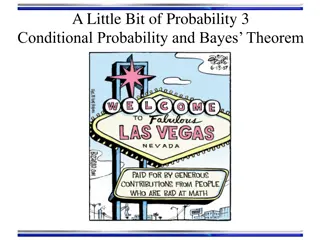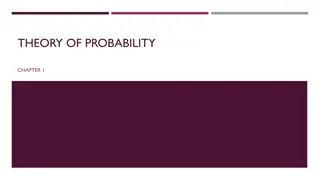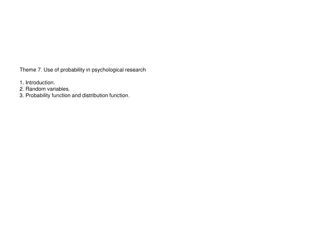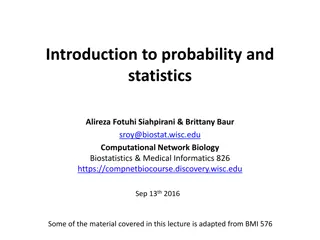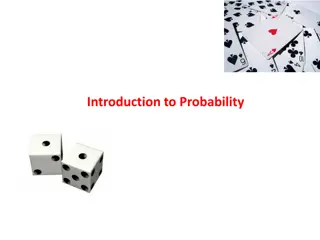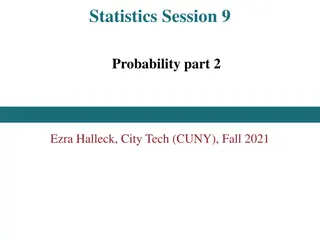
Understanding Discrete Uniform Distribution and Its Properties
Explore the concept of discrete uniform distribution, its definition, mean, variance, and properties like Bernoulli distribution. Learn how to calculate the mean and variance, along with key insights into the distribution's characteristics.
Download Presentation

Please find below an Image/Link to download the presentation.
The content on the website is provided AS IS for your information and personal use only. It may not be sold, licensed, or shared on other websites without obtaining consent from the author. If you encounter any issues during the download, it is possible that the publisher has removed the file from their server.
You are allowed to download the files provided on this website for personal or commercial use, subject to the condition that they are used lawfully. All files are the property of their respective owners.
The content on the website is provided AS IS for your information and personal use only. It may not be sold, licensed, or shared on other websites without obtaining consent from the author.
E N D
Presentation Transcript
BINOMIAL DISTRIBUTION CHAPTER 4
DISCERETE UNIFORM DISTRIBUTION A discrete random variable has a discrete uniform distribution if each value of the random variable is equally likely and the values of the random variable are uniformly distributed throughout some specified interval. In this article, I will walk you through discrete uniform distribution and proof related to discrete uniform.
Discrete Uniform Distribution Definition A discrete random variable X is said to have a uniform distribution if its probability mass function (pmf) is given by P(X=x)=1N,;;x=1,2, ,N. Discrete Uniform Distribution Graph Following graph shows the probability mass function (pmf) of discrete uniform distribution U(1,6).
Mean of Discrete Uniform Distribution How do you find mean of discrete uniform distribution? is given below with proof The expected value of discrete uniform random variable is E(X)=N+12. Proof The expected value of discrete uniform random variable is E(X)= x=1Nx P(X=x)=1N x=1Nx=1N(1+2+ +N)=1N N(N+1)2=N+12. Hence, the mean of discrete uniform distribution is E(X)=(N+1)/2.
Variance of Discrete Uniform Distribution The variance of discrete uniform random variable is V(X)=N2 112. Proof The discrete uniform distribution variance proof for random variable X is given by V(X)=E(X2) [E(X)]2. Let us find the expected value of X2. Now, the variance of X is V(X)=E(X2) [E(X)]2=(N+1)(2N+1)6 (N+12)2=N +12[2N+13 N+12]=N+12[4N+2 3N 36]=N+12[N 1 6]=N2 112. Thus the variance of discrete uniform distribution is 2=N2 112.
The discrete uniform distribution standard deviation is =N2112. Properties of a Bernoulli distribution: There are only two possible outcomes a 1 or 0, i.e., success or failure in each trial. The probability values of mutually exclusive events that encompass all the possible outcomes need to sum up to one. If the probability of success is p then the probability of failure is given as 1-p. The probability values must remain the same across each successive trial. Each event must be completely separate and have nothing to do with the previous event. i.e., the probabilities are not affected by the outcomes of other trials which means the trials are independent. The expected value for a random variable, X, from a Bernoulli distribution can be given as- E[X] = 1*(p) +0*(1-p) = p, for example if p=0.6, then E[X] =0.6 The mean of Bernoulli random variable(X) is E[X] = 1(p) +0(1-p) = p
A moment-generating function, or MGF, as its name implies, is a function used to find the moments of a given random variable. The formula for finding the MGF (M(t)) is as follows, where E is expected value: This is the general formula for finding an MGF under the condition that there exists a positive number b, such that b |t|. How we go about calculating this in practice differs depending on whether we're working with a discrete or continuous probability distribution.
STANDARD BINOMIAL VARIATE Variance of the binomial distribution is a measure of the dispersion of the probabilities with respect to the mean value. The variance of the binomial distribution is 2=npq, where n is the number of trials, p is the probability of success, and q i the probability of failure. The standard deviation is the square root of the variance of the binomial distribution.



